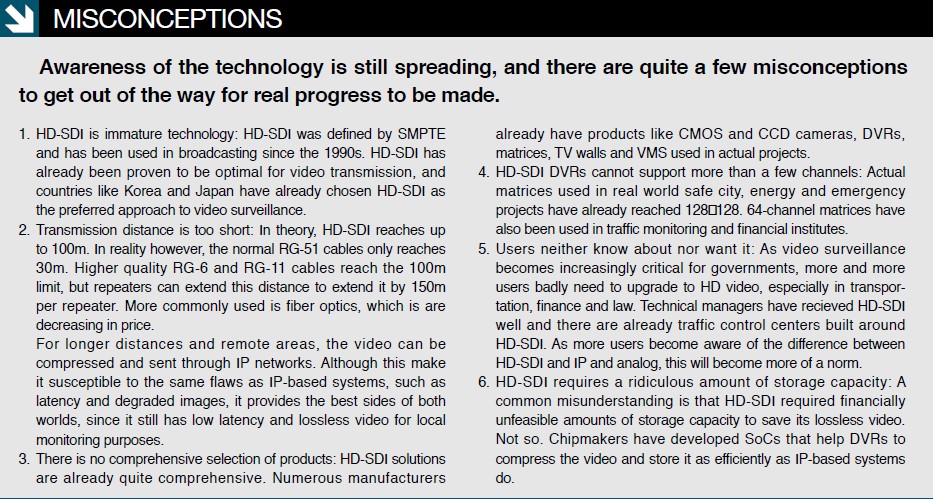IP-based video surveillance systems have been improving rapidly over the past few years, and there are fairly complete and sophisticated solutions out there, along with numerous product lines to choose from. But it was not always so. High prices, few selections, lack of options… Sound familiar? HD-SDI is still maturing, just as network cameras began to gain awareness back in 2002.
IP-based video surveillance systems have been improving rapidly over the past few years, and there are fairly complete and sophisticated solutions out there, along with numerous product lines to choose from. But it was not always so.
High prices, few selections, lack of options… Sound familiar? HD-SDI is still maturing, just as network cameras began to gain awareness back in 2002.
Analog Inheritance
Besides a selected few subcontracted installations in China and Korea, HD-SDI currently does not have any large-scale applications. Why? This is associated with the price of the switching, and storage requirements, said Alan Hayes, founder and MD, AMG Systems. "This can be compared with analogue video where all signals come back to the control room rather than IP systems where storage and switching is distributed.
“There is, however, an advantage to this approach. With HD-SDI DVRs, the structure of the system does not require any change at all. All the user needs is an SDI signal distributor to push the signals to a TV wall or LCD monitor.
Another benefit is that existing infrastructure can potentially be reused. For example, since banks are largely still using coaxial cables, they are in a great position to upgrade from analog to HD-SDI, providing that their cables reach a certain level of quality. This reduces their time and cost of installation, which appeals well to the keepers of cash.
However, existing cables are not guaranteed to work. Since HD-SDI is digital, it does not degrade gracefully like analog does, said Todd Rockoff, Executive Director, HDcctv Alliance. "Once the return loss exceeds the prescribed range, the signal ceases to be transmitted." Ultimately, installers bidding retrofits will need field testers to verify the status of the cables. According to the HDcctv Alliance, the ability to reuse legacy cable depends on the physical properties of that cable and the quality of its terminations. "Length is just one factor; core composition, wire gauge, cable run geometry, the integrity of the insulating layers, and so forth, also affect the result."
Maturing at a Rapid Pace
Other enhancements are also being made to increase HD-SDI's feasibility, such as extending its transmission distance, developing specialized displays for HD-SDI, and improving manageability.
Extending Distance
While short transmission distance has been a major downside for HD-SDI, improvements in chip technology and the debut of fiber link breaks HD-SDI away from the chains of coax. The current selection of transmission solutions is still limited for integrators and end users, but recent improvements show that HD-SDI is now suitable for many more applications than previously assumed.
Besides increasing bit rates, chips also use lossless compression to extend the distance to 300 m. However, the most common practice is to use fiber optic transceivers, which can use WDM/DWDM/CWDM to utilize different wavelengths of light to extend HD-SDI's reach to 30 km to 70 km, up from the paltry 100 m.
Multiple channels can be put on one fiber, but this will involve using different optical wavelength channels, one for each video channel, using CWDM technology, Hayes said. "CWDM does have a price premium, so it comes out relatively expensive. But from a technical point of view it is perfectly doable.
“Other benefits of the fiber approach are that other signals — Ethernet, data and so on — can be multiplexed onto the same fiber, thus saving materials and installation costs on the infrastructure.”
Specialized Displays
For the most part, current video surveillance displays use CVBS and VGA interface. When it comes to high definition video, two prominent formats are 720p and 1,080p. The HDTV SMPTE-296M/274M requires that the interface used to be HDMI or DVI and YC.
Most HD display manufacturers directly assume HDMI when it comes to HD-SDI, but in reality BNC is a more apt interface for SDI. Many displays already support HDMI-1080p, and displays with embedded SDI receivers and that support SDI connectors are available as well, albeit choices are currently limited to either small or large displays.
Video Management Not a Problem
HD-SDI originally lacked a unified platform for video management, but it is now possible to run the video through an SDI server to convert the signals to IP. The data can then be managed by any NVR or VMS.
In addition, the DVR can also output the video through its network interface into the VMS. The claim that HD-SDI does not have management platform no longer rings true.
For a highway project in Korea that had such a requirement, coaxial cables and fiber optics were used at the front end to transmit the signals to the traffic control center, then converted via HD-RX and convert the signals to BT.1120 and input into a network enabled DVR or HD-SDI video server. The VMS can then collect and manage all the DVRs on the network and control camera PTZ, all via standards.
As little as a few months ago, there were still many that expressed concern over whether matrix switchers could handle HD-SDI signals. Many even assumed that SDI could not be controlled as easy as analog, since SDI is not a composite signal like CVBS. However, with the help of chipmakers and developments in SDI equalizer circuit and SDI distributor, manufacturers now offer SDI control matrices.
